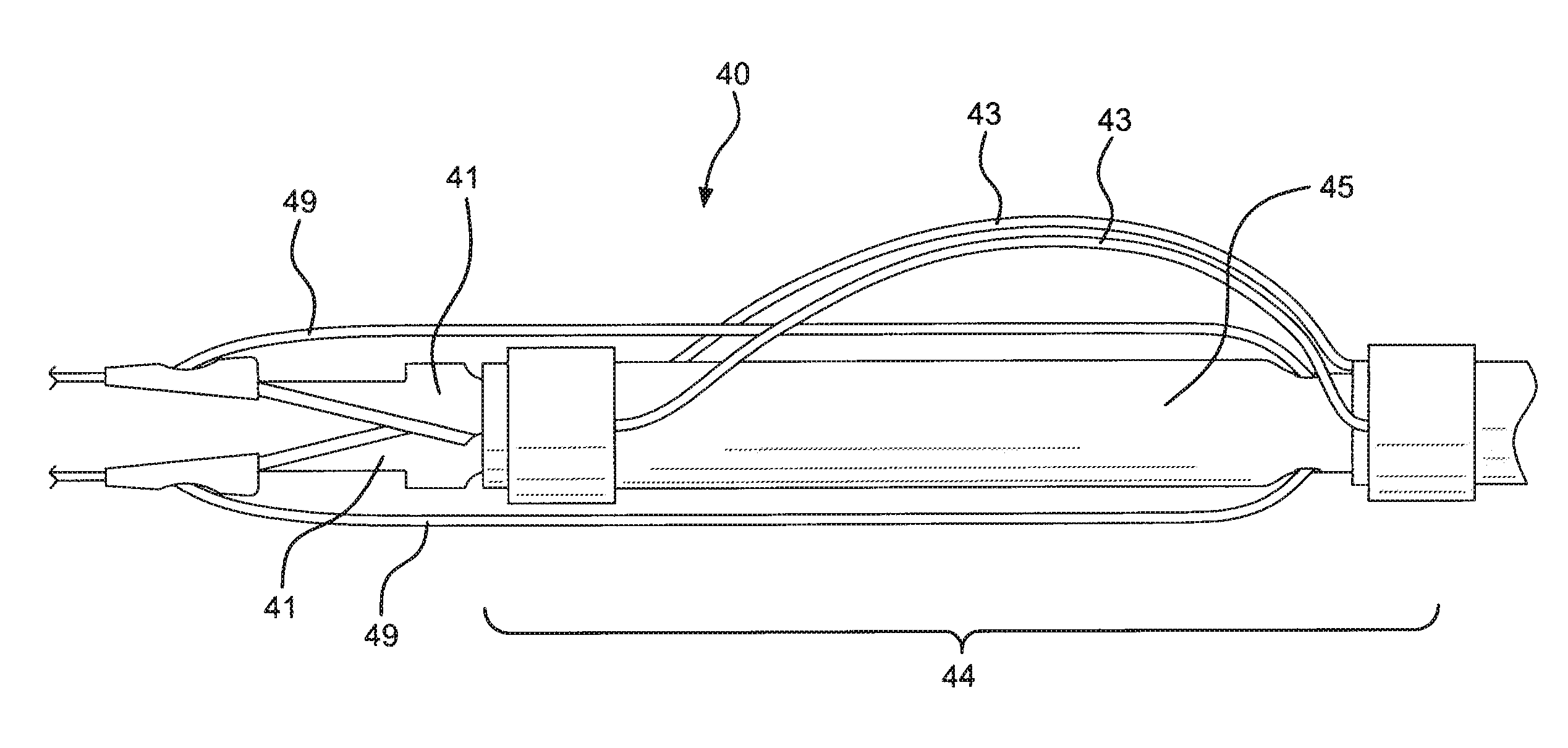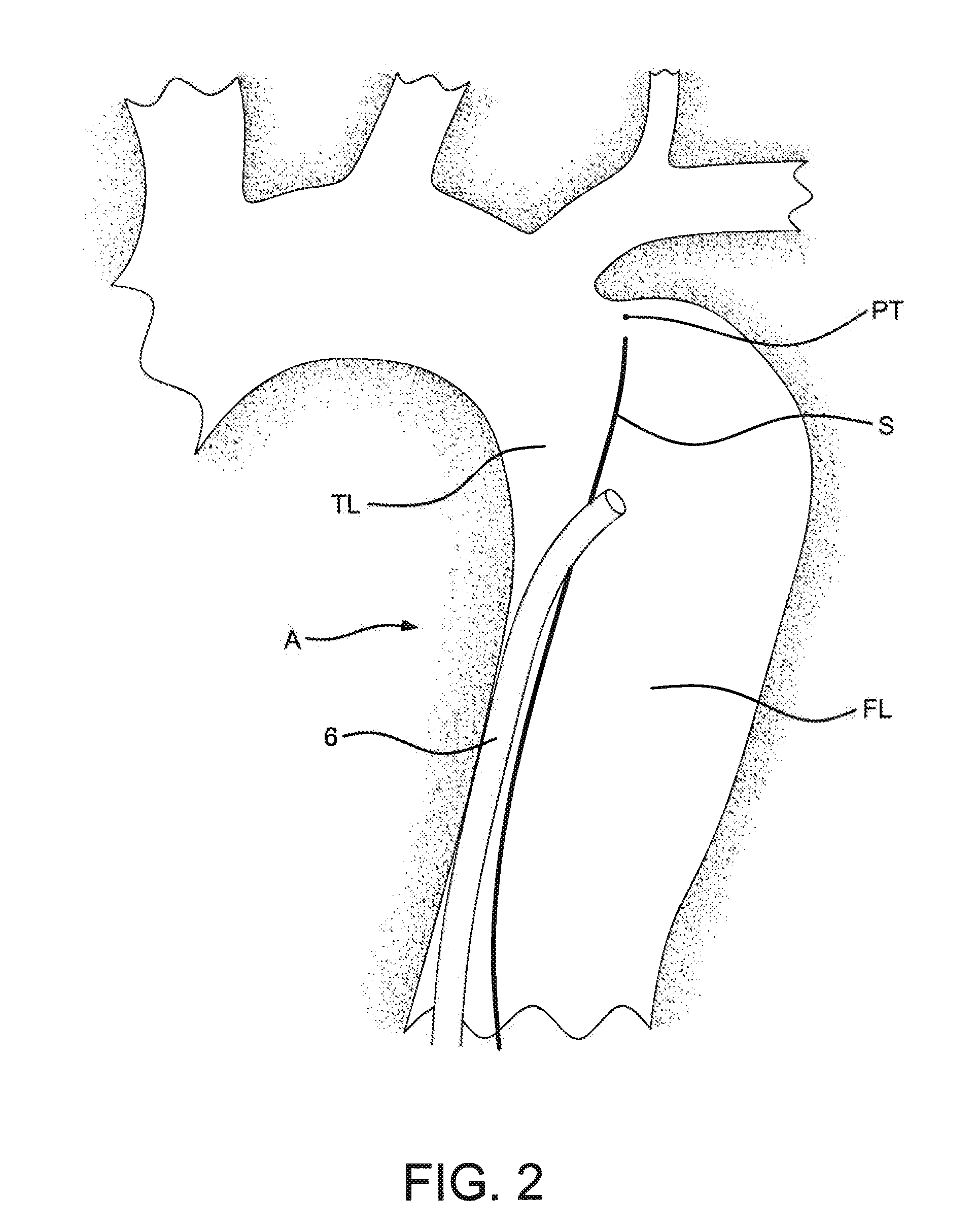Aortic dissection septal cutting tool
a cutting tool and aortic dissection technology, applied in the field of aortic dissection septal cutting tools, can solve the problems of severe complications and/or death, failure of blood vessels, and limited surgical ability to treat type b thoracic aortic dissections, and achieve the effect of precise cuts and little or no damage or trauma
- Summary
- Abstract
- Description
- Claims
- Application Information
AI Technical Summary
Benefits of technology
Problems solved by technology
Method used
Image
Examples
example 1
[0082]A catheter-based dissection septal cutting tool (1) of the present invention was constructed as follows (FIG. 12).
[0083]Initially, a cutting blade assembly (5) having a movable, or translatable, V-shaped cutting blade (4) was constructed (FIG. 7) and subsequently attached to a delivery catheter (6) as illustrated in FIG. 8. The movable cutting blade (4) is controlled and actuated with movable elongate member (2).
[0084]A cutting blade (4) for the cutting blade assembly (5) was made from a sheet of 316L stainless steel (0.25 mm thick) (McMaster Carr, Elmhurst, Ill.). The stainless steel sheet was cut into a rectangular section measuring 0.63 cm long and 0.24 cm wide. A 0.10 cm long V-shaped notch was center cut along the length of the section. The apex of the V-shaped cut had an angle of thirty-five (35) degrees. The edges of the V-shaped notch were sharpened using a grinder to form cutting blade (4).
[0085]A movable elongate member (2) for the cutting blade assembly (5) was made...
example 2
[0099]A cutting tool having a movable cutting blade and actuated, flexible, displacement elements was constructed as follows (FIGS. 14 and 15).
[0100]A delivery catheter (30) having one tubular component (31) placed inside another tubular component (32) in a coaxial relationship was obtained from W.L.Gore & Associates, Inc., Flagstaff, Ariz. The catheter is currently used in conjunction with the GORE VIABIL® Biliary Endoprosthesis.
[0101]The delivery catheter had a 3.07 mm outer diameter and is compatible with delivery systems and devices having diameters in the range of ten French (10 Fr). The delivery catheter has a component for mounting the GORE VIABIL® Biliary Endoprosthesis extending from one end of the catheter. The mounting component is a solid metallic shaft with a bulbous feature on the end of the shaft to assist in retaining the endoprosthesis on the shaft. The metallic shaft and bulbous feature were removed from the delivery catheter by cutting. The delivery catheter had a...
example 3
[0119]This example describes the construction of an embodiment of the present invention (40) having a cutting blade assembly (42) attached to a catheter (44) (FIG. 16). The cutting blade assembly (42) has a pair of remotely actuated scissor-like cutting blades (41). The invention also has a plurality of flexible displacement elements (43) attached to the cutting blade assembly (42) and the catheter (44).
[0120]Cutting blades (41) for the cutting blade assembly (42) were constructed as follows. A small bore stainless steel tube was obtained (1.6 cm long, 2.8 mm outer diameter, 2.4 mm inner diameter, Microgroup, Inc., Medway, Mass.). Approximately 1.5 mm from one end of the tube a 0.8 mm diameter hole was drilled through both walls of the tube. A 5.5 mm long, 1.5 mm wide slot was ground into the same end as the holes, perpendicular to the axis of the holes. A second slot of the same dimensions was ground into the opposite side of the tube. Two cutting blades were made from tool steel. ...
PUM
 Login to View More
Login to View More Abstract
Description
Claims
Application Information
 Login to View More
Login to View More - R&D
- Intellectual Property
- Life Sciences
- Materials
- Tech Scout
- Unparalleled Data Quality
- Higher Quality Content
- 60% Fewer Hallucinations
Browse by: Latest US Patents, China's latest patents, Technical Efficacy Thesaurus, Application Domain, Technology Topic, Popular Technical Reports.
© 2025 PatSnap. All rights reserved.Legal|Privacy policy|Modern Slavery Act Transparency Statement|Sitemap|About US| Contact US: help@patsnap.com



